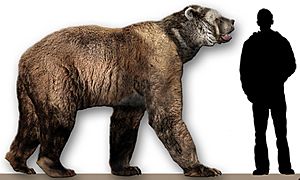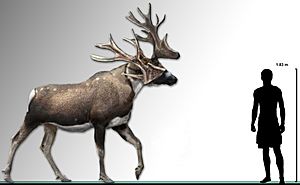Sheriden Cave facts for kids
Quick facts for kids Sheriden Cave |
|
|---|---|
| Lua error in Module:Location_map at line 420: attempt to index field 'wikibase' (a nil value). | |
| Location | near Carey, Wyandot County, Ohio |
Sheriden Cave is a very old archaeological site in Wyandot County, Ohio. It dates back to the late Ice age, more than 10,000 years ago. This means it was used by some of the first people to live in North America, known as Paleo-Indians. The cave was sealed off by natural deposits from glaciers a very long time ago.
Sheriden Cave is a special type of cave called a karst sinkhole. It formed in a rock called dolomite. This cave is connected to the Indian Trail Caverns, which opened in 1927. Sheriden Cave itself was found much later, in 1989. What makes this cave so special is that scientists found not only stone tools, but also tools made from bone. They also found bones of animals that are now extinct, and even old plant material. Scientists used a method called radiocarbon dating to find out that these items are between 11,000 and 12,000 years old.
Contents
Discovering Sheriden Cave
How Was the Cave Found?
In 1995, a bulldozer accidentally opened up the entrance to Sheriden Cave. At first, people studied the site because of the ancient animal bones found there. This is called paleontology. But soon, they found proof that humans had lived in the cave too!
Who Explored the Cave?
A professor named Kenneth Tankersley from Kent State University led the main exploration of the cave. He worked with his team and received help from the National Science Foundation. Their big dig started around 1997 and lasted for about three years.
Amazing Discoveries Inside
Tools and Artifacts from the Past

Inside Sheriden Cave, explorers found some very rare tools. These included spear points made from bone and a flint scraper used to prepare animal hides. They also found a special type of spear point called a "fluted" point. These tools are between 11,000 and 12,000 years old. Some of the items found belong to a group of early people known as the Clovis culture.
Animals That Lived Long Ago
Along with the tools, scientists found bones of animals that are no longer alive today. These animals lived during the Late Pleistocene epoch, which was the end of the Ice Age. Some of the amazing creatures found include the giant short-faced bear, a huge stag moose, the flat-headed peccary (a type of pig), and the giant beaver.
Well-Preserved Clues
The materials found in Sheriden Cave were very well-preserved. This is rare for such old sites in the eastern United States. They even found organic materials like gourds and ancient human waste. There was also a layer of wood charcoal, which shows that people made fires there.
Because so much was preserved, Sheriden Cave is very important. It helps us understand how early humans, the Paleo-Indians, lived in Ohio. It also helps us compare their lives to other early people who came to the Americas by crossing the Bering Strait.
Climate Change and Early Humans
Professor Ken Tankersley found that people lived in the cave about 11,500 years ago. This was a time when the climate and environment were changing a lot. Today, a historical marker is placed near the cave, and the entrance is fenced off to protect it.
Other Ancient Sites in Ohio
Sheriden Cave is not the only place in Ohio where we find clues about Paleo-Indians. Other important sites include the Paleo Crossing Site in Medina County, the Nobles Pond Site in Stark County, and the Welling Site in Coshocton County.
Images for kids




